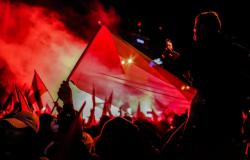Protests Anew in America – A Statement

Scott Montgomery with a call to remember history and its nuance.
Protests that have roiled many university campuses in the U.S. are now beginning to wind down. Rivers of commentary have followed related events at selected institutions, with the usual mix of blindness and insight. This has included a call on anti-war demonstrators from the late 1960s (early 70s, however, was when the movement reached its peak) to make comparisons. The impulse is a good one: today’s protests can’t be dismissed and shouldn’t be ignored in terms of their own historical meaning.
Such movements, whatever their aims, are intensely symbolic in their attempts to alter perception and install moral-ethical absolutes. Their naiveté and simplifications can appear self-defeating, worthy of disdain—witness the calls to cut off all relations with Israel, whether financial, intellectual, or familial. But this is to miss the point. The use of disruption to shatter the ordinary and create events of local, national, and global conversation is itself an invocation of symbols. An encampment on the campus green, particularly in this era of homeless tent sites, qualifies as an invasion. Suddenly, angry and partisan ideology seizes a space intended for calm passage and quiet reflection.
The anti-war protests of the 60s and early 70s were drenched in history. As I.F. Stone and other commentators then observed, this was a generation raised on the milk of US military heroism in Europe and the Pacific. How had it soured so terribly into the opposite? Once a liberator of towns and cities, now it was the destroyer of villages, fields, and families, searing children with napalm, spraying poison to defoliate. Now it was pulling thousands of its own youth out of ghettoes and universities to go carry out these same atrocities. In 1971, when it was clear the war was going badly, the draft was extended to college students. The causes of activism were potent. The American flag had become a symbol of brutal hypocrisy. Calls to “halt the spread of communism” rang hollow in face of carpet bombing and the My Lai massacre.
That the protest movement of 2024 has chosen the war in Gaza, thus the Israeli-Palestinian conflict, mirrors the historical moment no less but in a complex way. The failures of democratic liberalism are not only pertinent; they are at the core. The war translates to many of this generation in the terms of colonialism and violent suppression of minority groups, ethnically defined. This connects with the anti-war movement of a half-century ago—a presumably liberal state becoming the pitiless opposite.
But the link ends there. The evils at issue are not the same as at that earlier time. The great shadows cast over the 20th century globe had other names in the first decades after WWII: fascism, Naziism, totalitarianism, ultra-militarism. Israel was a state built from the ashes of the Holocaust, the greatest barbarity ever perpetrated by humankind against itself, beyond imagining in its horrors. A tiny state, moreover, it had endured repeated assaults by the combined forces of surrounding nations, driven by race hatred as in WWII. These are bare bones of the view at that time, but bones nonetheless. They are how students tended to see the situation. It would not change with the illegal Israeli settlements in the West Bank, in part due to the 1972 murders of the Israeli Olympic team in Munich and yet another multinational Arab assault only months later.
Over the last several decades, meanwhile, a major shift has occurred in U.S. public memory regarding the atrocities of history. Time has been a factor in this. Most students today have little connection to WWII. To them, it is a war that happened in black-and-white,
comparable in distance to WWI for the protestors of 1970. Such distance, however, is not inevitable, as the surge of attention to slavery and segregation shows. It is more that America tarnished its image further through support for violence in Latin America, aid to dictators in many parts of the world, the disastrous invasion of Iraq, and more. The triumph of reactionary conservatism, with its race-baiting attack on welfare, embrace of white evangelicalism, use of the Southern Strategy, and embrace of an angrier, uncompromising form of politics, did its part as well. On the left, many in academia turned away from the analysis and lessons of WWII, as if its fierce and violent ideologies had somehow vanished (only to find them very much alive and surfacing in more recent times). For a large portion of the professoriate, the true and continuing source of historical evil was no longer totalitarianism but colonialism and its aftermath, in which the U.S. played a global part.
Along the way, non-white peoples replaced Jews as the primary victims of modernity’s racist, murdering impulses. It is an overlooked aspect to the campus protests of today that they represent, in part, a collision between these two eras of atrocity. For many of today’s students, antisemitism isn’t part of the racist ideology created by the “imperial West.” Despite ancient origins and over two thousand years of brutality,
hatred of Jews comes up short weighed against prejudice directed toward BIPOC (black, indigenous, people of color). Impossible as it may sound, for more than a few, the Holocaust comes up short when compared to the centuries of colonial oppression. This reality makes the simplifications of the current anti-Zionist/anti-Israel protests both easier and more likely to slip or skid into antisemitism.
Simplification, to be sure, is the very stuff of activism. Protest relies on splitting any situation into just and unjust, victims and victimizers. The problem with the war in Gaza is that this just isn’t possible without erasing the entire history of the conflict, including that of Hamas, its declared mission, October 7 attack, and treatment of its own people. When this history is given even a nod, the rationale for protest turns against both the Netanyahu regime (and supporters) for its monstrous carnage and the Hamas leadership for its unconscionable willingness to murder Israelis and to sacrifice so many thousands of its own people, including children.
Without history, activism is blind. The anti-war and anti-apartheid movements were rooted in an awareness of longstanding, cruel injustices to the Vietnamese and to black South Africans. While the destruction of Gaza is an appalling outrage, slogans to “Free Palestine” (not Palestinians) or, more baldly, to “Kill all Zionist colonizers” (as sprayed on a statue of George Washington at my university), appear unaware of the echoes they reveal from the first half of the last century. Zionism itself, we might recall, had its modern birth in the pogroms of the Pale—Russia, the true embodiment of imperialist violence today in its effort to erase a nation of 38 million.
Photo by Ömer Faruk Yıldız


